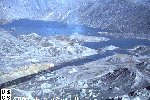
USGS/Cascades Volcano Observatory, Vancouver, Washington
DESCRIPTION:
Monitoring Mount St. Helens Debris-Dam Lakes
- Monitoring Mount St. Helens Debris-Dam Lakes
- Photo Archives - Debris Dam Lakes
|
Monitoring Mount St. Helens Debris-Dam Lakes
|
From:
Brantley and Topinka, 1984,
Volcanic Studies at the
U.S. Geological Survey's David A. Johnston Cascades Volcano Observatory,
Vancouver, Washington: Earthquake Information Bulletin, v.16, n.2,
March-April 1984
-
The debris avalanche raised the level of Spirit Lake 64 meters and dammed its
natural outlet even higher. Many small ponds filled closed depressions on top
of the avalanche deposit, and several lakes formed in tributaries dammed by the
avalanche; the largest lakes formed in the tributaries of
Coldwater and Castle Creeks.
In late 1980, some of the ponds overtopped and swiftly eroded their new
outlets. The rapid release of water generated highly erosive flows on the
avalanche and transported large volumes of sediment down the lower reaches of
the Toutle and Cowlitz Rivers.
-
Failure of the debris dams holding
Spirit, Coldwater, and Castle
Lakes would result in catastrophic mudflows comparable to or larger than those
of May 18, 1980. Controlled outflow channels have been constructed to stabilize
the water levels of Coldwater and Castle Lakes, and water from Spirit Lake is
currently being pumped into the Toutle River by the Corps of Engineers as a
temporary measure to control its level
(Web note: 1984 publication).
Permanent solutions are being
considered to alleviate the flood threat from Spirit Lake.
-
Six lake gages, maintained by the Geological Survey in cooperation with the
National Weather Service and the Federal Emergency Management Agency, monitor
the water levels of Spirit, Coldwater, and Castle Lakes. The gages serve as an
emergency warning system if one of the debris dams fails. Each gage has at
least two recording instruments that transmit several lake elevations each hour
by way of a satellite to a ground receiving station in Tacoma, Washington. If a
lake level drops faster than the specified rate, alert transmissions send lake
elevations every 5 minutes.
-
Overtopping of the debris dams due to filling from normal precipitation was
considered to be the most likely cause of lake breakouts and resulting floods;
controlled outlet channels and the Spirit Lake pumping operation have eliminated
this possibility. However, a sudden influx of a large volume of volcanic debris
from an eruption of Mount St. Helens could raise rapidly the level of Spirit
Lake. An eruption producing pyroclastic flows more voluminous than those of May
18, 1980, would be necessary to cause overtopping.
-
Several geologic and geophysical studies evaluate and monitor the potential
instability of unconsolidated material that blocks the lakes.
Failure of these debris dams could result from slumping of the dams,
liquefaction from shaking during earthquakes, or headward erosion of gullies and
channels. The studies suggest, however, that these possibilities are unlikely in
the near future.
-
A seismic zone about 1,000 kilometers long trends north-northwest through Mount
St. Helens and beneath the debris-avalanche deposit. During recent decades,
several significant earthquakes have occurred along this zone, the largest of
which was magnitude 5.5 and occurred in February 1981. Ground-water
wells and seismometers on the surface of the avalanche deposit and in holes 6 to
30 meters deep are used to monitor the response of the unconsolidated debris to
earthquake activity.
-
The relatively narrow debris blockage at Castle Lake is most subject to
slumping or gravitational failure.
Instruments in drill holes as deep as 30 meters monitor
slope movements of the Castle and Spirit Lake dams, and ground-water tables are
recorded at all three lake blockages. Erosion is monitored by repeated
photographs and channel geometry surveys.
|
Photo Archives - Debris-Dam Lakes
|
-
 [Image,80K,JPG]
[Image,80K,JPG]
Outlet channels have been built at Castle Lake and Coldwater Lake
(shown here) to stabilize water levels and prevent overtopping
of the debris dams.
-- USGS Photo by Lyn Topinka, October 17, 1981
-
 [Image,143K,GIF]
[Image,143K,GIF]
Aerial view, Spirit Lake pump station.
From late 1982 through the spring of 1985, a pump station operated
at Spirit Lake to maintain that lake at a safe level. Without pumping,
Spirit Lake was estimated to overtop its debris dam within a year.
-- USGS Photo by Lyn Topinka, September 23, 1983
-
 [Image,94K,JPG]
[Image,94K,JPG]
In the spring of 1985 a permanent tunnel was opened, allowing water
to drain out of the lake safely. This tunnel is 11 feet (3.4 m) in
diameter and more than 1.5 miles (2.5 km) in length. The water level
of Spirit Lake is now maintained at approximately 100 feet (30 m)
below the estimated overtopping level.
-- USGS Photo by Lyn Topinka, October 2, 1986
 MORE Mount St. Helens Photo Archives - Lakes and Reservoirs
MORE Mount St. Helens Photo Archives - Lakes and Reservoirs
Return to:
[Volcano and Hydrologic Monitoring Menu] ...
[Hydrology and Hydrologic Processes Menu] ...
[Natural Debris-Dam Lakes Menu] ...

URL for CVO HomePage is:
<http://vulcan.wr.usgs.gov/home.html>
URL for this page is:
<http://vulcan.wr.usgs.gov/Monitoring/Descriptions/description_monitor_msh_lakes.html>
If you have questions or comments please contact:
<GS-CVO-WEB@usgs.gov>
09/22/04, Lyn Topinka
 [Image,80K,JPG]
[Image,80K,JPG]
 [Image,143K,GIF]
[Image,143K,GIF]
 [Image,94K,JPG]
[Image,94K,JPG]
 MORE Mount St. Helens Photo Archives - Lakes and Reservoirs
MORE Mount St. Helens Photo Archives - Lakes and Reservoirs

